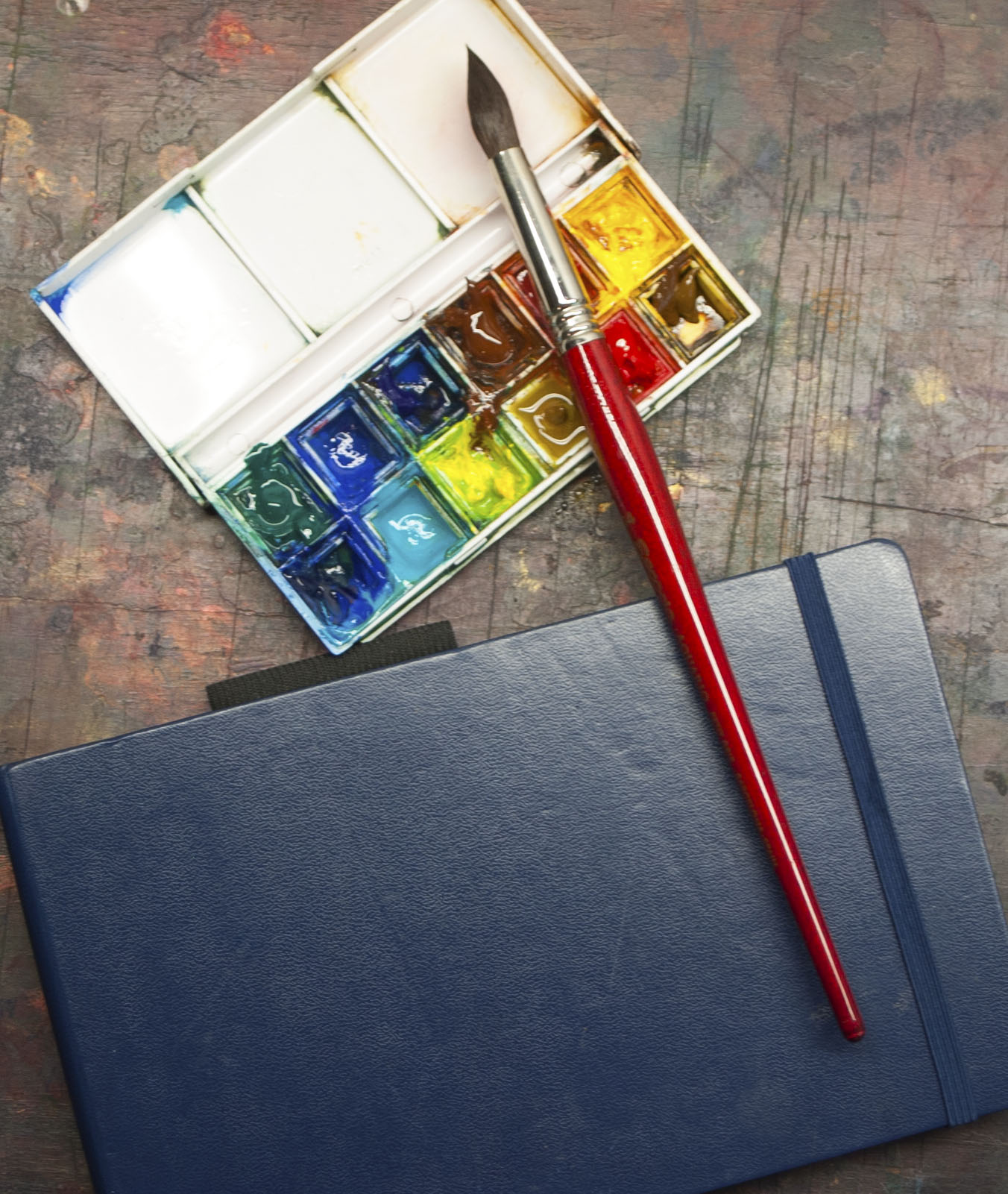Your brushes are your second most important tool in watercolor painting, next to your paper. But since your watercolor brush lasts hundreds of paintings and your paper only lasts one painting, it's worth investing in a good brush that suits your painting style.
While you can paint good paintings with a bad brush, it's much harder to paint well. So don't bother with bad brushes. They usually don't last long and are frustrating while they're around. On the other hand, the most expensive brush is not necessarily the best brush for you.
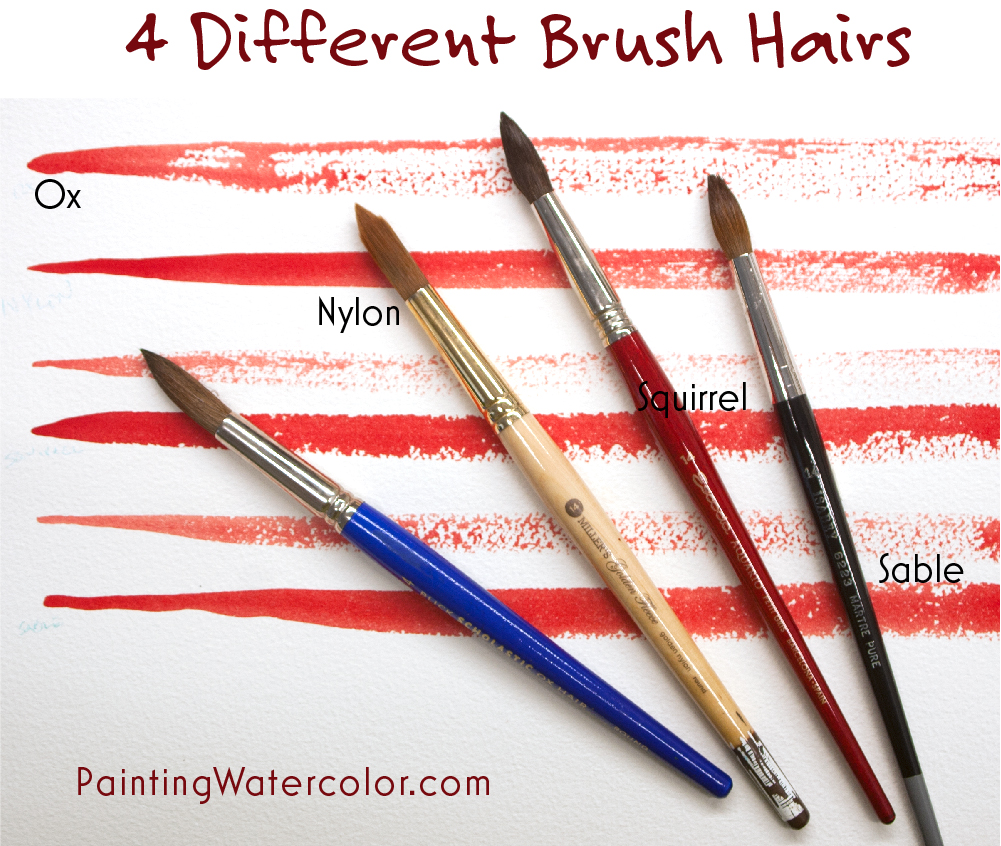
Brushes don't last forever, just a very long time when treated well. They are tools meant to be used. From medium price range up (-20), cost is not necessarily an indicator of quality. (For really cheap brushes, low price usually means low quality.) Lots of house brands are made by very well known manufacturers. And well known manufacturers outsource some lines, so never pay just for a name.
Most artists keep a few ratty brushes around, well past when you'd think they would be good for anything. Sometimes a blown out brush is perfect for tree texture or a stub of a brush is perfect for pulling out highlights. You never know until you find the perfect tool to achieve what you want.
A good brush will last hundreds of paintings. Brushes are disposable, though. They have only so many paintings in them before they simply can't achieve the tiny lines you want. When they get to that point, either repurpose them or throw them away. There is no point in frustrating yourself.
Once you've reached a certain level in brushes, it's more about the artist's skill than the quality of the brush. A good brush makes watercolor painting easier and more fun. It's not a magic wand!
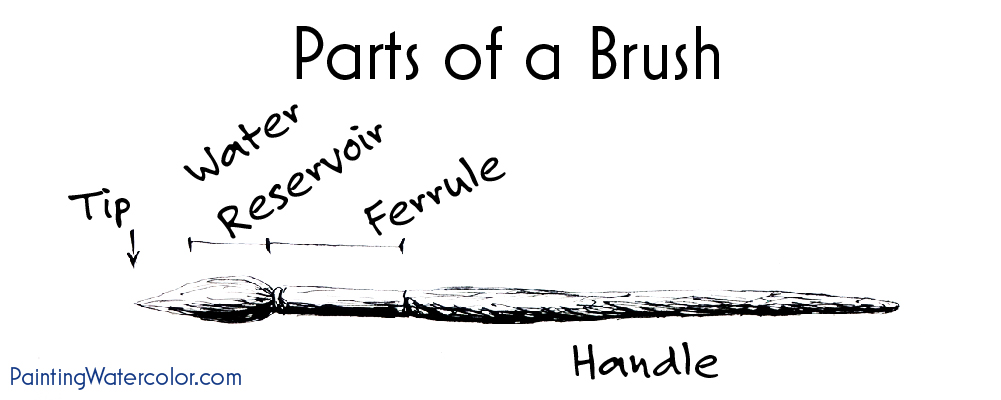
| Handle | The handle should be made of solid hardwood, such as beech. It should feel good in your hand. It shouldn't be weighted unevenly where it flops or you have to hold it at the ferrule. You want it to feel like an extension of your hand. You're going to be holding it for hours! Not all brushes are comfortable for all artists. |
| Ferrule | The ferrule is the metal part of the brush. It should be smooth, with no gaps for water to leech in and rot the handle. Seamless is best. It should be double or triple clamped evenly. This makes for a solid seal. Most Asian brushes are attached directly to their handle with no ferrule. |
| Heel | Brush hairs are clamped in the heel. You don't want to see gobs of glue here. That means it hasn't been well made. |
| Hair or Tuft |
The hair should lie sleek, with no stray hairs flying out. The type of hair changes the brush completely. The shape, stiffness and water retention of the hair type makes the brush. Types of hair and properties are explained below. You only see about half the hair. The other half is in the ferrule for a firm hold. The tight clamp of the ferrule holds the hair in the brush, not glue, which would break down with the rough treatment we artists give brushes. The hair on a good brush is shaped into place, not trimmed. Brush making is very much a fine craft, with years of experience used in making the best brushes. |
| Belly | The belly of the brush holds your water reservoir. How much water stays in the brush changes the type of stroke and how long you can paint for. How it distrubutes the water changes how the stroke looks. Is it going to let all the water go at once or in a steady stream? |
| Tip | The part you actually paint with! This is the only part that touches the paper. It must come to the type of point / edge you want. For example, this nylon brush with a few hairs bent at the tip. Just this tiny bit is enough to ruin the brush for fine lines. |
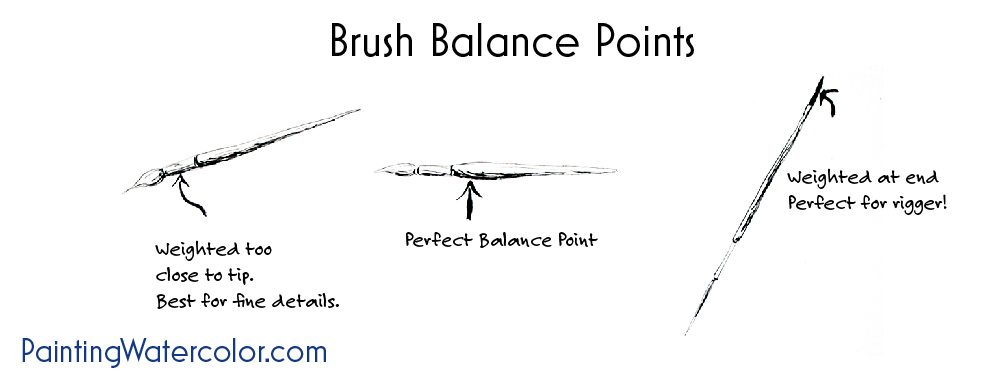
Different types of brushes are weighted for different strokes. The handle shape and material, brush hair and length, ferrule weight and size can all change the balance point of the brush. A brush for tiny delicate strokes will naturally be held close to the brush hairs, near the ferrule. A rigger or liner brush should be held near the tip of the handle for long smooth strokes. As a general rule, the bigger and longer the strokes the brush is designed for, the further from the hair your hand should be.
My ideal basic round brush's balance point will be a bit past the ferrule, where the handle will naturally bulge slightly to enhance your grip. A minature artist would have a completely different balance point preference.
Knowing how you like your brushes balanced means you can choose the best brush to suit YOUR painting style.
Frankly, if you find a big brush (such as the #14 Ox Hair Scholastic in my video lesson) weighted heavily toward the tip, it's not going to be a great brush. It's going to feel heavy and clunky in your hand.
Disclaimer: Jennifer Branch Gallery is a participant in the Amazon Services LLC Associates Program, an affiliate advertising program designed to provide a means for sites to earn advertising fees by advertising and linking to amazon.com. I receive a small rebate for your entire order (starting at 4%) if you choose to purchase through Amazon. Most items can be bought multiple places and I highly recommend local art stores if you have one! Any other recommendation links I receive no compensation for.
These referrals help me support this website, and I thank you for any purchase you make through them. I will never recommend a product I have not used frequently and believe is the best tool for the purpose!
Different Brush Hairs
Different brush hairs lead to vastly different effects.
Let's start off with the fact that cold climates lead to longer haired animals whose hairs are best for watercolor brushes.
That's why so many excellent brush hairs are sourced from Siberia.
Snap refers to filling a brush with water and flicking the water off sharply. The brush should snap to a sharp point if it's supposed to have a sharp point.
Spring means how flexible the brush is at different strokes.
Can you paint a zigzag and have the brush move with your hand smoothly? Or does it obstinately remain in the shape it started at?
Different brush hairs have different amounts of spring and snap.
A video lesson comparing 4 different brush hairs in a #14 round brush.
| Hair Type |
Description |
Uses | Example |
| Kolinsky Sable | The only consensus on the title of Kolinsky is that, besides being the most expensive and best brushes, they are sourced from
cold climate (Kola in Siberia) rodents. The very best Kolinsky is from male Kolonok weasels or Mustela sibirica's winter tail hair. It's not a sable, but a weasel. There is no such animal as a Kolinsky sable. The hairs are brown orange with a darker tip. The hair is in a conical shape, so it's naturally wider at the base with a pronounced fine tip, perfect for pointed brushes. Many brushmakers make "Kolinsky" sable using other parts of the animal's pelt, the summer coat, a female Mustela sibirica, or another Mustela (weasel) family. For example, it's pretty standard practice to mix male / female hair about 60% / 40% in a brush. Perhaps because of all the confusion about what Kolinsky sable actually is, the US Fish and Wildlife stops most shipments of Kolinsky brushes coming to the United States, so Kolinskys of any description are expensive and hard to find here. The US Fish and Wildlife and CITES are concerned about the possibility of endangered species being used. Mustela siberica is wild caught and labelled least concern under endangered species, but similar to a lot of endangered rodents. Most brush manufacturers have decades worth of tufts that doesn't have the new required paperwork. So while it's unlikely endangered species are being used, manufacturers have no proof and most brush shipments are confiscated or returned currently. Good Kolinsky sables are worth the expense and trouble in return for years of consistent brushstrokes. Poor quality Kolinskys are still expensive and much worse than synthetics. Good Kolinsky brushes hold a point beautifully (minature artists need them!) and have a lovely water retention that allows for smooth strokes. |
Multipurpose Fine lines to broad strokes Excelent water retention and release |
|
| Red Sable | Red Sable can mean either the less desirable parts of the Mustela's coat, other Mustela, mink, the Martes (marten or sable). The dark brown hair is blunter than the Kolinsky sable. Some of the Martes family are endangered. Red sable and Kolinsky sable are interchangeable terms to many manufacturers. However, there is a definite quality difference. Red sable is nice to paint with, but not as durable, long or as fine a point as Kolinsky. I usually buy red sable brushes because I run through brushes quickly. I'd rather get a top quality Isabey red sable than a low quality Kolinsky sable brush. |
Multipurpose Fine lines to broad strokes Excellent water retention and release |
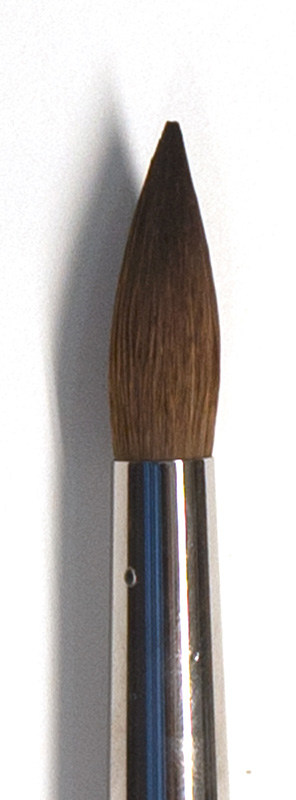
Isabey Red Sable Brush |
| Squirrel | The best is Kazan squirrel, again from Siberia. Some squirrel comes from northern Canada. Squirrel is a soft fine absorbant hair that comes to a fine point. It holds an amazing amount of water - more than sables. It's usually dark brown or speckled brown. Squirrel has practically no spring, very limp to use. But it glides over cold and rough press paper hitting and missing patches for a beautiful effect. |
Gorgeous washes. Traditionally used for sign painting because of its precision, however, I find the hit and miss strokes it offers to be the most useful. I use a squirrel brush on location a lot because it's easier to keep my painting loose. Used for Mops and Wash brushes |

Blick Squirrel Round Brush |
| Boar Bristles | Much stiffer brush. Really more used for acrylics and oils. Not good for washes since it doesn't hold much water. Mostly just used for texturing. |
Scumbling, Texture | |
| Ox or Sabeline | A light brown, sometimes dyed red to resemble sable. It doesn't hold a lot of water and releases water unevenly. Ox hair is strong, but doesn't point well since the ends fray and the hairs are about the same width along their length. Not springy. |
Scumbling, Texture Usually marketed as a "student" brush, but it will frustrate most students. You can paint well with ox hair, but you have to know how to paint first! |

Blick Ox Round Brush |
| Goat | Soft, not springy. The hairs are cylinders so a fine tip isn't possible. Think calligraphy brushes or big washes. | Washes | |
| Synthetic | Sythetics such as golden taklon, toray nylon, etc. are pretty amazing. The "hairs" can be made tapered like the finest sables and come to a good point. Many synthetics are mixed with natural hairs to improve their points, so if you're vegan, check the label carefully. Sometimes nylon emulates a natural hair. Sometimes it's mixed with it. Synthetic watercolor brushes don't hold water quite the same as sables or squirrel. If you want to paint in hit and miss strokes, they can't do that. Synthetic brushes are best at very even, short strokes. They don't hold as much water and they don't release it as smoothly. Water and paint tend to come in bursts rather than in a smooth flow. They do hold water now, unlike the first nylon brush attempts. Little flags or frays are added to the hairs to grab water droplets like natural hair.Synthetics are constantly improving. And if you want to use a huge brush, most sables only go up to #14 rounds, but synthetics go all the way. And cost a lot less! You can be rougher with synthetics - you can attack the paper and really pull out paint. No animal cruelty is good, though all natural brush hairs are industry byproducts. Synthetic brushes are all petroleum byproducts. I've painted with synthetic hair brushes as part of my tool kit for years. They're useful workhorses, especially for lifting paint. And if you're looking for a huge #38 round, nylon is your best option. Nylon only decreases in strength about 15% when wet, so it's the optimal choice. Toray nylon is a propietory type of nylon from a Japanese company. Taklon nylon Polyester |
Multipurpose | 
Miller Nylon Round Brush |
| Camel | Definitely not camel, an industry name for any cheap brush hair | Don't buy this! It's meant for kids' paint sets. |
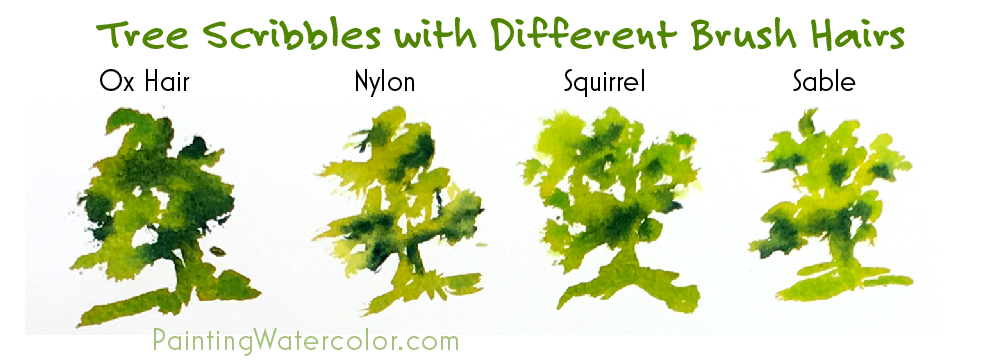
Different brush hairs completely change how the paint flows.
My recommendations for brushes? Don't buy very expensive brushes until you have been painting awhile. Your style may change. For example, I never use flats so an expensive flat would be wasted.Start with a very few good quality basic synthetics and once you know the shapes and sizes you like, then buy your dream brushes.
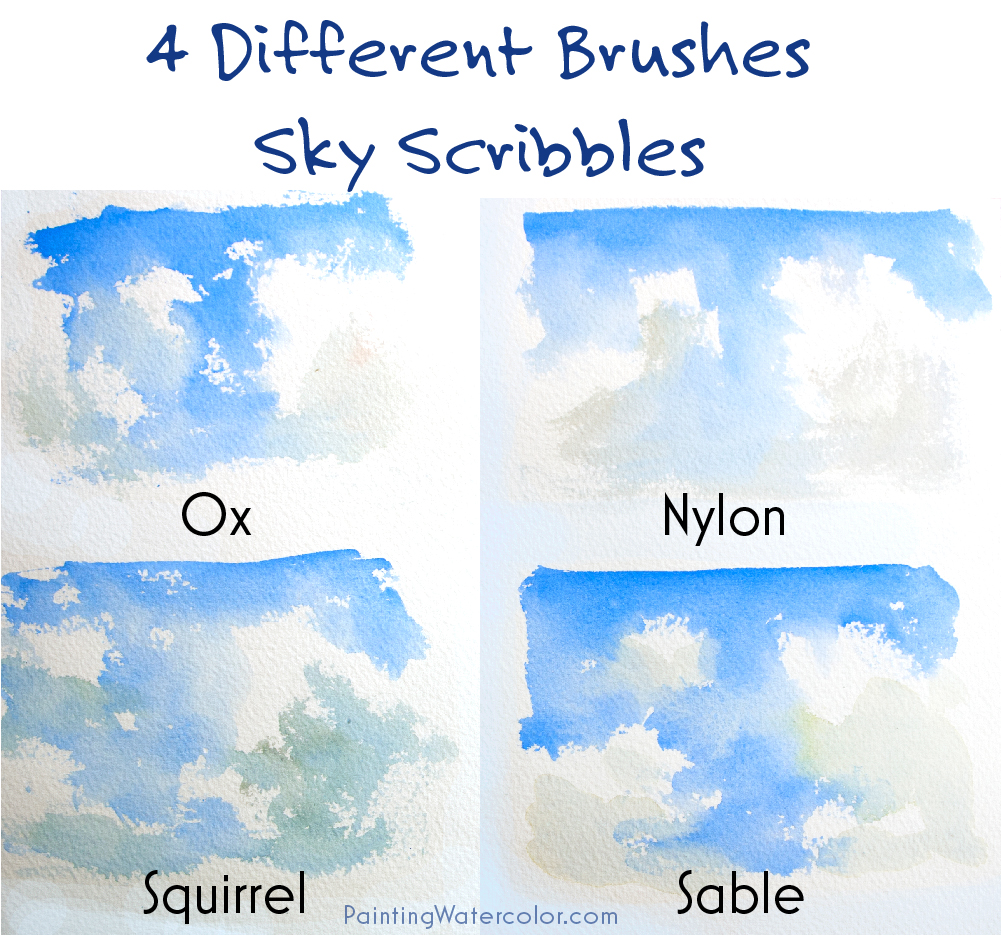
Different brush hairs completely change how the paint flows. I hgihly recommend playing with brushes in the store. They will usually let you scribble gently with plain water to test a brush.
I used primarily synthetics for years. A good synthetic will not hold you back in painting.Lately I've been enjoying mixing in some natural hairs, especially squirrel because of the huge amount of water it holds.
Always keep in mind that brushes do wear out eventually. When a pointed brush no longer comes to a sharp point, it's worn out. They last a lot longer with good care. Always rinse your brushes completely free of pigment after a painting session. Never let your brushes soak in the rinse water. That's a quick way to rot the wood and brush hairs.
I hope this article gives you some ideas about what the best watercolor brush for you is. Happy Painting!



